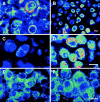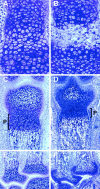Bcl-2 lies downstream of parathyroid hormone-related peptide in a signaling pathway that regulates chondrocyte maturation during skeletal development
- PMID: 9008714
- PMCID: PMC2132464
- DOI: 10.1083/jcb.136.1.205
Bcl-2 lies downstream of parathyroid hormone-related peptide in a signaling pathway that regulates chondrocyte maturation during skeletal development
Abstract
Parathyroid hormone-related peptide (PTHrP) appears to play a major role in skeletal development. Targeted disruption of the PTHrP gene in mice causes skeletal dysplasia with accelerated chondrocyte maturation (Amizuka, N., H. Warshawsky, J.E. Henderson, D. Goltzman, and A.C. Karaplis. 1994. J. Cell Biol. 126:1611-1623; Karaplis, A.C., A. Luz, J. Glowacki, R.T. Bronson, V.L.J. Tybulewicz, H.M. Kronenberg, and R.C. Mulligan. 1994. Genes Dev. 8: 277-289). A constitutively active mutant PTH/PTHrP receptor has been found in Jansen-type human metaphyseal chondrodysplasia, a disease characterized by delayed skeletal maturation (Schipani, E., K. Kruse, and H. Jüppner. 1995. Science (Wash. DC). 268:98-100). The molecular mechanisms by which PTHrP affects this developmental program remain, however, poorly understood. We report here that PTHrP increases the expression of Bcl-2, a protein that controls programmed cell death in several cell types, in growth plate chondrocytes both in vitro and in vivo, leading to delays in their maturation towards hypertrophy and apoptotic cell death. Consequently, overexpression of PTHrP under the control of the collagen II promoter in transgenic mice resulted in marked delays in skeletal development. As anticipated from these results, deletion of the gene encoding Bcl-2 leads to accelerated maturation of chondrocytes and shortening of long bones. Thus, Bcl-2 lies downstream of PTHrP in a pathway that controls chondrocyte maturation and skeletal development.
Figures







References
-
- Allsopp TE, Wyatt S, Paterson HF, Davies AM. The proto- oncogene bcl-2can selectively rescue neurotrophic factor–dependent neurons from apoptosis. Cell. 1993;73:295–307. - PubMed
-
- Boise LH, González-García M, Postema CE, Ding L, Lindsten T, Turca LA, Mao X, Nunez G, Thompson CB. bcl-x, a bcl-2–related gene that functions as a dominant regulator of apoptotic cell death. Cell. 1993;74:597–608. - PubMed
Publication types
MeSH terms
Substances
Grants and funding
LinkOut - more resources
Full Text Sources
Other Literature Sources
Molecular Biology Databases
Research Materials

